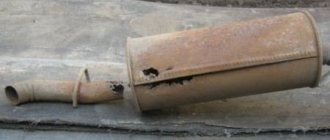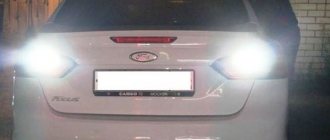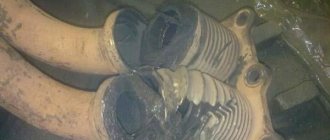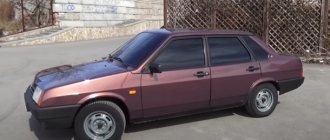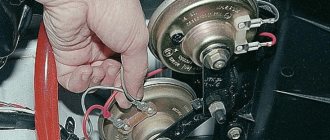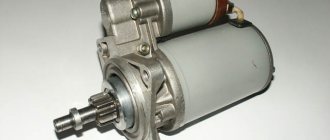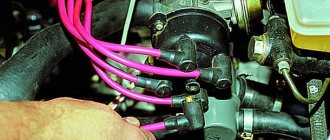The starter on the VAZ 2115 is used to start the internal combustion engine. It transmits the rotating motion to the crankshaft. If the unit is excessively worn or damaged, it becomes impossible or difficult to start the car.
Therefore, as soon as the first symptoms of a malfunction appear, attention to the unit is urgently required. It is necessary to diagnose the starter and, based on its results, make a decision on further repair or replacement of the unit.
Starter problems and their elimination
In a situation where the starter does not turn, and the traction relays continuously click, the reason why the car does not start is a discharged battery. A low battery charge does not provide sufficient current to the electric motor to crank the crankshaft. To prevent overheating of the electric motor, the traction relay is turned off, which creates a clicking sound.
The appearance of extraneous noise during starter operation, accompanied by a decrease in the intensity of crankshaft rotation, is a consequence of wear or damage to the bushing. To check its condition, it is necessary to disassemble the starter and inspect the contact surface with the shaft for scoring and other damage. If there are any defects, it is recommended to replace the bushing with a new one.
The weak point in the mechanical part is the bendix. Its gear wears out and becomes damaged. The malfunction can be identified by external inspection of the Bendix. Particular attention should be paid to the condition of the gear teeth, which is shown in the photo below.
A common electrical problem is a breakdown to the housing. You can check the insulation using an ohmmeter or multimeter. If the listed devices are not present, then the light bulb connection diagram below will help identify insulation damage.
Attention should be paid to the brush assembly. All brushes should move without jamming. The presence of melts and other thermal or mechanical damage to the guides is unacceptable. If defects are present, replacement is recommended.
The brushes transmit a large current to the commutator plates. This leads to melting and other thermal damage on contacting surfaces. Therefore, during troubleshooting, it is most important to inspect the condition of the commutator and brushes.
Differences between starter and relay failure
In order not to confuse what exactly has failed - the starter or the solenoid relay, there is an excellent method for recognizing the “culprit”.
- Remove the starter, connect the negative terminal of the battery to ground;
- The design of the device has copper bolts and a tongue-shaped element;
- The positive wire from the battery is connected to this “tongue”;
- If there is contact, the solenoid relay clicks and starts working;
- If not, then you will have to go to the store for a new relay.
But there is one more very important point. Even if all the facts indicate that the starter or retractor relay is not working, another unit - the ignition switch - may still be the cause of ignition problems. Take the time to check its serviceability before buying new parts.
Article number and approximate price for the original VAZ 2115 starter
The original VAZ 2115 starter has the internal factory marking 423.3708. For the carburetor version of the car on sale, the unit has article number 2108370801006. Its price is 2,500 rubles.
On VAZ 2115 cars that have an injector, an improved starter is used. It has a planetary gear and provides more stable rotation of the crankshaft. The unit goes on retail sale with article number 21130370801000. Its cost starts from 5,500 rubles.
VAZ 2114 starter does not turn, causes and malfunctions
Of course, before removing the starter, you need to find out whether the problem is not in it at all, but for this you need to know at least a little what malfunctions it has.
Main faults of the VAZ 2114 starter
- The bendix (overrunning clutch) is faulty.
- The stator or armature winding has short-circuited.
- Solenoid relay is faulty.
- Worn or stuck brushes.
- Bushing wear.
All these malfunctions relate to the starter, but there are other reasons for which the starter does not turn: oxidation or poor contact at the battery terminals or its complete discharge, a break in the power wires that go to the starter, and perhaps the ignition switch or its contact group is faulty .
Causes such as oxidation of the battery terminals can easily be eliminated on your own; to do this, you just need to clean them and lubricate them with technical petroleum jelly or lithol, which you have available, and charge the discharged battery, of course.
If the reason arose in the contact group, you can try to clean the contacts, but if this does not help, then most likely it will need to be replaced, and you may have to completely replace the ignition switch.
It will be impossible to eliminate faults that are directly related to the starter without removing it, so consider this point in more detail.
Catalog number and cost of starter from third-party manufacturers
According to reviews from car owners, the quality of VAZ 2115 starters does not correspond to their cost. There are a large number of defects among the products. Therefore, experienced drivers recommend purchasing analogues of branded products from third-party manufacturers. The best alternative options for the original starter for the VAZ 2115, which have proven themselves well on the car, are presented in the table below.
Table - Good analogues of the original VAZ 2115 starter
| Manufacturer | vendor code | Approximate cost, ruble |
| Startvolt | LST0115 | 2800-3500 |
| HC Parts | CS332 | 2700-3600 |
| As-pl | S9008 | 1800-2500 |
| Bosch | 986014950 | 7500-10000 |
| Lucas Electrical | LRS00714 | 7200-9000 |
DESIGN FEATURES AND OPERATING PRINCIPLE
The starter on the VAZ 2114 (5712.3708) has an operation cycle, which can be divided into four main stages:
- After turning the ignition key, the fourteenth battery in the contact chain begins to supply power to the starter and traction relay;
- The Bendix gear drive (overrunning clutch) is connected to the flywheel;
- At the moment the gear drive is connected, power begins to be supplied to the electric motor of the unit;
- The electric motor begins to spin the drive, the revolutions of which are transmitted to the crankshaft of the car, as a result of which the engine starts. When the engine speed begins to exceed the starter speed, the drive and the crankshaft are disconnected.
Now let's look at the design features of the fourteenth starter. In the diagram below you can see the main elements of the device.
Starter device
- Housing - is made in the form of a cast steel cylinder at the ends, closed with lids, inside which the cores and the exciting winding (stator) are located;
- Solenoid relay - consists of a movable jumper and power contacts. The purpose of the solenoid relay is to close the contacts when the ignition is turned on, as a result of which power begins to be supplied to the electric motor. Upon completion of the operating cycle, the solenoid relay disconnects the power and the device turns off;
- Bendix of the VAZ 2114 starter (aka overrunning clutch) - at the beginning of the operation of the device, the bendix is connected to the crankshaft and transmits the electric drive speed to it through the engagement gear; at the end of the cycle it is disconnected. The serviceability of the entire device depends on the normal functioning of the bendix, since if disconnection does not occur at the moment when the engine speed exceeds the speed of the electric drive, the unit will be damaged;
- Anchor - is a cast axle made of alloy steel, onto which collector plates and a core are pressed;
- Brushes and brush holders are structural elements that are necessary to supply power to the armature. Properly functioning brushes increase the power of the device's electric drive;
- The starter bushing - there are three in total: the rear and front - are pressed into the body, the third is located at the junction of the armature and the bendix. The bushings are responsible for fixing the drive shaft.
Required Tools
In order to perform replacement and repairs yourself, you will need the tools from the table below.
Table - Tools required to replace the front strut
| Name | Note |
| open-end wrench | "at 8", "at 10", "at 13" |
| Head | "at 13", "at 14", "at 15" |
| Ratchet | With extension |
| Silicone Grease | For working with rubber |
| Pliers | Can be replaced with pliers |
| Screwdriver | With cross and flat blade |
| Spanner | "at 13", "at 14", "at 15" |
| Wire brush and rags | To clean dirt |
| Penetrating lubricant | For example, WD-40 |
Preparing to replace the bendix: removing the starter on a VAZ-2114
The starter can be accessed from above or from underneath. Let's consider the second option: roll the car into the pit and use the handbrake. Next, use a 10mm wrench to unscrew two screws from the bottom (photo 1) and two screws on the side members.
Down with the mudguard!
Finally, remove the screws on the cross member (photo 3) to remove the engine splash guard.
On a VAZ-2114, you can replace the bendix in one way - remove the starter.
The location of the starter under the hood is marked with a red arrow.
For this:
- Unscrew the nut securing the power wire to the starter (photo 1). Remove the terminal and also disconnect the block with the control wire (photo 2);
- Using a spanner or socket wrench, unscrew the three fastening nuts - with them the starter is pressed to the crankcase;
- The assembly can now be removed.
Installation is carried out in reverse order.
Starter replacement process
In order to remove and mount the starter on a VAZ 2115, you must follow the instructions presented below.
- Apply the parking brake, securing the vehicle in place.
- Open the hood.
- Remove the negative terminal from the battery. To make work easier, many car owners recommend dismantling the battery. In this case, you will need to disconnect the positive terminal from the battery.
- Disconnect the terminal block of the mass air flow sensor.
- To gain access to the place where the starter is located, you will need to remove the air filter by first disconnecting the air duct.
- Remove the metal corrugation of the air duct from the fasteners.
- Disconnect the connector from the solenoid relay and unscrew the power wire.
- Using a ratchet with an extension, unscrew the starter mountings.
- Remove the starter from the engine compartment.
- Install a new node to replace the old one.
- Reassemble everything in the reverse order of removal.
- Check the functionality of the starter by performing a test run of the internal combustion engine.
When trying to remove the starter, car owners often encounter sticking of its fasteners. In this case, access from the bottom of the machine will be required. To do this, the VAZ 2115 should be installed on a lift, inspection pit or overpass.
How to remove the Niva Chevrolet starter with your own hands
Has your Chevrolet Niva stopped starting or is running intermittently? The reason for this could be a faulty starter. In such a situation, it should be removed, disassembled and possibly partially replaced. Removing the Niva Chevrolet starter with your own hands will not be any problem.
Preliminary diagnosis
Before dismantling the starter, you must make sure that this device is the cause of the malfunction. This can be done visually or by replacing the battery with a working one.
It is also worth checking whether current passes from the battery to the starter: if current passes, then the cause of the malfunction is the starter, but if current does not pass, then the starter relay should be checked. If the latter malfunctions, it must be replaced.
If everything works, then the next step is to remove the starter.
Step-by-step replacement of the Chevrolet Niva cooling radiator
How to remove the Niva Chevrolet starter
To remove the starter, you need to do the following:
- Disconnect the wires from the battery and starter (you can use a wrench of the required size).
- We unscrew the starter, which is attached with three bolts to the box body. You can remove it through the top or bottom, however, motorists believe that it is more convenient to remove it through the bottom. It's difficult to do this without a pit. Air conditioning can be another obstacle. If it is present, you will also need to remove the warm air intake hose. The clamp that secures it to the engine can be loosened using a flathead screwdriver.
Now you need to determine the cause of the failure. There may be several of them:
- Faulty brushes. If they are worn out and do not reach the anchor, they should be replaced.
- Faulty retractor. In this case, replacement is necessary.
- Knocked out guide bushings also require replacement.
- The cause of the breakdown may be a burnt-out winding or a burnt-out armature. It is difficult to repair such a malfunction at home; it is better to contact a specialist.
The wires leading to the starter need to be cleaned and lubricated, and also checked to see if current is flowing through them. If necessary, it is better to replace the power cord, because it can cause poor operation of the device.
If the cause of the breakdown is identified and eliminated, then the next step is to install the starter. You need to do this in reverse order:
- Connect the wires first, then mount the starter and tighten the three bolts;
- screw back the rod that covered the starter outlet and the engine protection;
- connect the battery and check if everything works.
Recommendations for using the starter
To make your starter last longer, you need to follow a few simple recommendations:
- If you turn on the engine, then this should be done no longer than 15-20 seconds, and repeated no earlier than after 25-30 seconds. If after three times the engine does not start, you need to check the ignition and power system. If such faults are detected, they must be corrected.
- Do not use the starter to move the vehicle. This puts a lot of stress on the trigger mechanism.
- If you have successfully started the engine, turn off the starter, as the overrunning clutch may jam due to frequent rotation of the starter drive gear by the flywheel.
Anyone who has already removed and installed the starter at least once is unlikely to want to do it a second time. Although this work is not difficult, it requires a lot of effort and sometimes money. Follow these simple rules to avoid such breakdowns.
Where is the Niva Chevrolet hydraulic chain tensioner located and its malfunctions
VAZ 2115 starter relay: causes of malfunctions
VAZ 2115 is one of the most worthy creations of the Volga automobile industry. In common parlance, this car is called a tag; it is truly considered one of the most popular and inexpensive cars on the domestic market, produced since 1997.
The car earned its popularity quite honestly, since operation and repair do not pose any particular problems to the car owner. However, there are breakdowns that everyone who owns this wonderful car should know about.
We will talk about the starter relay, its breakdowns and how to repair it.
Starter relay location
What do you need to know about the starter relay for the VAZ 2115?
The starter itself is a four-pole DC motor that is powered by electricity from the battery. A technical inspection of the starter must be done every 100,000 km.
Based on the principle of its operation, the starter consumes quite a powerful current, so even minor fluctuations in resistance can significantly reduce its performance and lead to complete breakdown. In order to make sure that the failure is in the relay, it is necessary to do a check.
However, before performing this type of check yourself, be very careful to avoid possible injury. We turn on the ignition and turn the key, if the starter does not work, but you can hear some characteristic clicks, this means the relay is working, but the starter itself will have to be disassembled.
If the situation is the opposite and when you bridge the contacts on the back wall of the starter without removing it from the engine you will hear the mechanism spinning, then the whole problem is in the relay.
VAZ 2115 starter
The principle of operation of the VAZ traction relay
The starter coil, which receives power from the battery, creates a magnetic field that acts on the armature. It starts to move, compressing the return spring, which engages the bendix, which connects to the splines of the flywheel crown.
The contacts of the elements close, the retracting winding remains without power, but the armature remains inside the coil, as it is held by a strong magnetic field.
After the engine starts, the coil loses its power and the armature accordingly returns to its original position. In this case, the bendix itself disengages.
Starter relay malfunction
There are several options for checking the relay, which can be used to determine whether it is faulty.
- When starting the engine, the starter does not turn off on its own. This can easily be determined by the fairly loud and sharp buzzing that can be heard in the interior of the VAZ 2115;
- When you turn the key in the ignition switch, a click is clearly heard, but nothing happens and the starter does not start;
- When you turn the key, the starter allegedly starts working, but the engine does not start.
In most VAZ cars, the relays are similar to each other, differing only in the way they are attached to the starter. And unfortunately, breakdowns that specifically affect the relay in 95% of cases end in its replacement.
But still, before making this diagnosis, you need to make sure of one more serviceability, namely the functionality of the contacts at the place where the wire and terminal are soldered.
Often, due to oxidation, the contact is lost, and by soldering it again, you can get rid of the problem of the starter relay breaking, provided that after this procedure the car is fully operational.
Any service station will help you perform such a replacement, but this pleasure is relatively expensive. A much cheaper way would be to do everything yourself. If the owner of the car knows his ward 2115 inside and out, then such a replacement can be made independently without much effort, knowing the specific sequence of actions.
Relay replacement: sequence
Before starting work, it is necessary to turn off the power from the battery, because while the electrical circuit is being created, it is prohibited to remove the starter, since you can completely burn out the entire wiring of the car.
- Clean the surface of the starter from dirt and dust;
- Unscrew the nut from the relay bolt and remove its contact;
- Unscrew the screws that secure the relay to the starter body;
- Remove the nuts from the end and divide the starter into 2 parts;
- Remove the old core and put a new one in its place;
- Reassemble all components in reverse order and check serviceability by connecting to the battery;
- Install the starter with the replaced relay on the car engine and check the operation.
Before checking the starter on the VAZ car itself, it is necessary to check that all the contacts that are present in this design are in their correct position and ultimately do not lead to a short circuit, because whatever one may say, we are dealing with current. The operation of the relay is checked first at idle, then while driving, more precisely during sudden braking.
Thus, following the exact recommendations, you can replace the starter relay yourself, but before you start removing and disassembling the starter itself, you need to check the indicators described above and make sure that the whole problem is in this particular part of the car, otherwise the wasted effort will not solve the main problem. Problems. If you haven’t identified the problem, then experienced service station employees will always help and do everything necessary for you!
Source: https://autodont.ru/jelektro/rele-startera-vaz-2115-polomka-i-sposob-zameny
